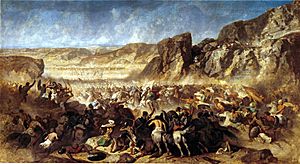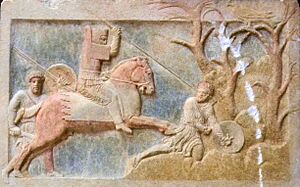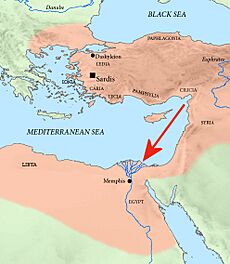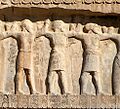Artaxerxes II facts for kids
Quick facts for kids Artaxerxes II𐎠𐎼𐎫𐧁𐏂 |
|
|---|---|
|
|
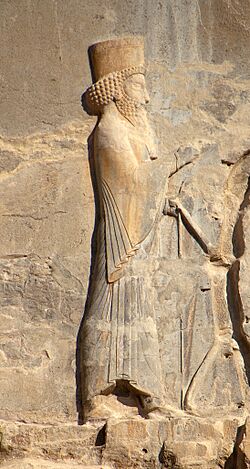
The Rock relief of Artaxerxes II in Persepolis
|
|
| King of Kings of the Achaemenid Empire | |
| Reign | 405/4–359/8 BC |
| Predecessor | Darius II |
| Successor | Artaxerxes III |
| Born | Arses c. 436 BC (or 453 BC) |
| Died | November 359 – April 358 BC |
| Burial | Persepolis |
| Spouse | Stateira |
| Issue among others |
|
| Dynasty | Achaemenid |
| Father | Darius II |
| Mother | Parysatis |
| Religion | Zoroastrianism |
Artaxerxes II was a powerful ruler of the Achaemenid Empire, an ancient Persian kingdom. He was known as the King of Kings from about 405 BC to 358 BC. Born as Arses around 445 BC, he was the son of Darius II and Queen Parysatis.
Artaxerxes II faced many challenges during his long rule. One of his biggest challenges came from his younger brother, Cyrus the Younger. Cyrus tried to take the throne, leading to a major battle. Artaxerxes also had to deal with several revolts across his vast empire.
Later rulers of the Parthian Empire looked up to Artaxerxes II. They even claimed to be his descendants.
Contents
Who Was Artaxerxes II?
Artaxerxes II's birth name was Arses. This name comes from an Old Persian word meaning "man" or "hero." He was also sometimes called Arsaces. The later Arsacid dynasty, which ruled the Parthian Empire, took their name from him.
The name Artaxerxes comes from Old Persian Artaxšaçā. It means "whose reign is through truth." The Greeks also gave him the nickname "Mnemon." This means "remembering" or "having a good memory."
Learning About Artaxerxes II
Most of what we know about Artaxerxes II comes from ancient Greek writers. These writers often focused on the western parts of his empire. His younger brother, Cyrus, hired many Greek soldiers. Because of this, we have good records of Artaxerxes' early reign until Cyrus' death in 401 BC. After that, detailed information becomes harder to find.
One important Greek writer, Plutarch, wrote a book about Artaxerxes II. This book is the only biography of an Achaemenid king. However, historians today say we should be careful when reading it.
Early Life and Family
Arses was the oldest son of Darius II. Darius II ruled the Persian Empire from 424 to 405 BC. Arses' mother was Parysatis, who was also Darius II's half-sister.
Darius II and Parysatis had many children, but most died young. Arses' known full brothers were Cyrus, Ostanes, and Oxathres. He also had an older sister named Amestris. Cyrus was likely born around 424 BC. When he was about 15, Cyrus became a governor (satrap) of important regions like Lydia. He gained a lot of power.
Before becoming king, Arses married Stateira. She was the daughter of a Persian nobleman. This marriage helped create a political alliance for Darius II.
When Darius II was dying, Arses was by his side. Some ancient writers say that Arses' mother, Parysatis, wanted Cyrus to be the next king. However, most modern historians believe Arses was already chosen as the heir.
Arses was crowned king in Pasargadae. During his coronation, he took the throne name Artaxerxes. Some stories say Cyrus tried to kill his brother at this time. But this event is not certain. It seems the transfer of power was mostly peaceful.
Artaxerxes II's Reign
Conflict with Cyrus the Younger (401 BC)
Artaxerxes II's younger brother, Cyrus, wanted to be king. Cyrus gathered a large army, including many Greek soldiers. He claimed he was the rightful heir because he was born after their father became king.
Artaxerxes II tried to make peace, but it did not work. The two brothers' armies met at the Battle of Cunaxa in Babylon in 401 BC. Cyrus' army fought well and won the battle. However, Cyrus himself was killed during the fighting. This made his victory meaningless.
A Greek historian named Xenophon was part of Cyrus' army. He later wrote a famous book called the Anabasis. It tells the story of the 10,000 Greek soldiers who had to find their way home after Cyrus' death.
Wars with Sparta (396-387 BC)
Artaxerxes II also got involved in a war with the Spartans. This was called the Corinthian War (395-387 BC). The Spartans had invaded parts of Asia Minor. To stop them, Artaxerxes II paid a lot of money to other Greek cities. These cities included Athens, Thebes, and Corinth.
He used thousands of darics, which were Persian gold coins. These payments helped start a war against Sparta in Greece. This forced the Spartans to bring their army home. One Spartan king even said he was "driven out by 10,000 Persian archers." He was talking about the gold coins, which had an archer on them.
The Persians, working with Athens, destroyed the Spartan navy in 394 BC. This helped Athens become powerful again. But Artaxerxes II soon worried that Athens was getting too strong.
The King's Peace (387 BC)
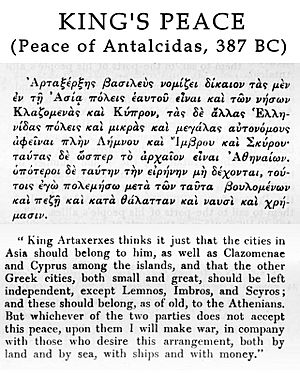
In 386 BC, Artaxerxes II made a deal with Sparta. This agreement was called the Treaty of Antalcidas, or the King's Peace. It gave Persia back control of Greek cities in Asia Minor. It also made Sparta the most powerful state in mainland Greece.
Egyptian Campaign (373 BC)
Artaxerxes II had trouble with the Egyptians. They had successfully rebelled against Persian rule earlier in his reign. In 373 BC, he tried to conquer Egypt again. He sent a large army led by Pharnabazus.
The Persian force included 200,000 Persian soldiers and 12,000 Greek fighters. They landed in Egypt near Mendes. However, the Egyptian ruler, Nectanebo I, had strengthened his defenses. The Persian army was too slow.
The Persian fleet tried to sail up the Nile River. But the Egyptians had blocked the channels and flooded the land. The Persian generals also did not trust each other. This stopped them from reaching the capital city of Memphis.
Soon, the annual Nile flood began. This made it even harder for the Persians. The Egyptian defenders fought bravely. What looked like a sure defeat for Egypt turned into a complete victory. The Persian expedition failed.
Revolt of the Satraps (372-362 BC)
The failure in Egypt caused problems for Artaxerxes II. Many governors (satraps) in the western part of the empire started to rebel. This was known as the Great Satraps' Revolt. The Egyptian Pharaoh Nectanebo helped these rebellious satraps with money.
Artaxerxes II eventually managed to stop these revolts. By 362 BC, he had regained control over his empire.
Peace Efforts in Greece (368-366 BC)

Artaxerxes II tried to help make peace between the Greek city-states. He sent an envoy to Greece to help negotiate. His goal was to create a "Common Peace" among the warring Greek cities.
However, the negotiations failed. The Greek cities could not agree on terms. Sparta and Athens were not happy with the Persian king's support for Thebes. They decided to secretly help those who were fighting against Artaxerxes II.
Building Projects
Artaxerxes II spent a lot of his wealth on building projects. He restored the Palace of Darius I at Susa. He also improved the city's defenses. In Ecbatana, he added a new hall and sculptures.
Tomb at Persepolis
The tomb of Artaxerxes II is located in Persepolis. It was built like the tombs of earlier kings. On the tomb, there are carvings of the Emperor. He is supported by soldiers from all the different groups in his empire. Each figure has an inscription describing their ethnicity.
-
Tomb of Artaxerxes II in Persepolis.
-
Tomb of Artaxerxes II in Persepolis.
Religious Beliefs
Since the time of Darius the Great, Persian kings honored Ahura Mazda as their main god. Artaxerxes II was the first king to also clearly name other gods in his inscriptions. In an inscription at Susa, he mentions Anahita and Mithra along with Ahura Mazda.
Artaxerxes II was the first king to officially recognize Anahita. She was the goddess of "the Waters." She was linked to fertility, healing, and wisdom. He encouraged people to worship Anahita. He built temples and statues for her across the empire. This included temples in Ecbatana, Susa, and Babylon.
The temple of Anahita in Istakhr was probably built by Artaxerxes II. Later, in the 3rd century AD, the Sasanian family repaired and decorated this temple. They were the traditional caretakers of the temple.
Legacy of Artaxerxes II
Artaxerxes II's reign was long and full of challenges. His conflict with Cyrus the Younger was a major event. It led to a period of instability and revolts across the empire. He is also remembered for restoring monuments built by earlier kings. His biggest restoration project was the Palace of Darius in Susa. His tomb in Persepolis is also a lasting reminder of his rule.
Greek writers often showed Artaxerxes II as a king who faced many problems. They focused on his struggles to control his empire. They also wrote about issues within his royal court.
Family Life
Artaxerxes II had many wives. His main wife was Stateira. She was poisoned around 400 BC. Artaxerxes II is said to have had many children.
- Children by Stateira
- Darius
- Ariaspes
- Ochus (who became Artaxerxes III)
- Rhodogune
- Atossa
- Sisygambis
- Other children
- Arsames
- Mithridates
- Phriapatius
- Amestris
- Apama
- Ocha
See also
- The Anabasis
- Ten Thousand (Greek)
|
Artaxerxes II
Born: c. 436 BC Died: c. 358 BC |
||
| Preceded by Darius II |
King of Kings of Persia 404–359/8 BC |
Succeeded by Artaxerxes III |


